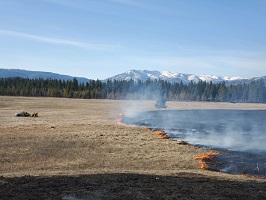International Journal of Wildland Fire
Volume 30
Number 8 2021
Longer duration, federal wildland fires in the USA are commonly represented by low and moderate risk. Regional variations in wildfire risk are evident, with the West Coast using ‘high’ risk and the South-west and Eastern regions opting for ‘low’. Federal agencies also present different risk patterns. Photograph by Dr Russell Parsons.
This paper evaluates the computationally efficient Multivariate Adaptive Constructed Analogs (MACA) method for downscaling a single general circulation model to a fine scale over the state of Victoria, Australia. Comparison with a 4-km fire weather climatology dataset shows the method well reproduces observed statistics of mean and extreme fire weather. Photo showing planned burn in Victoria, Australia, by Tim Brown.
Twelve GCMs are downscaled over Victoria, Australia, to estimate trends in fire weather frequency under two emissions scenarios using the Multivariate Adaptive Constructed Analogs (MACA) method. Increases of ~50–200% in the number of Very High or above fire danger days are likely by 2100, mostly due to higher temperatures. Photo showing smoke from a planned burn in Victoria, Australia, by Nick McCarthy.
Flaming and smouldering durations doubled in masticated litter beds. This was attributable to higher fine and coarse fuel loads on the forest floor. This could have implications for levels of soil heating and smoke emissions. However, the effect was short-lived, with surface fuel loads declining over 4 years to pretreatment levels.
Approximately 30% of NIPF landowners will implement fuel reduction treatments to meet various forest management objectives, including wildfire hazard reduction, in the next five years. Landowners can potentially be motivated to regularly implement treatments through provision of technical assistance, prioritisation of areas with higher wildfire hazard and promotion of collaborative programs.
Dung beetles play numerous essential ecosystem services and are sensitive to habitat alterations. Mountains are fragile ecosystems increasingly subjected to wildfires. Dung beetles in Mediterranean high-altitude habitats are sensitive to vegetation type, but not to fire because of their recolonisation capabilities and preference for open habitats.








